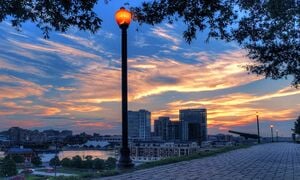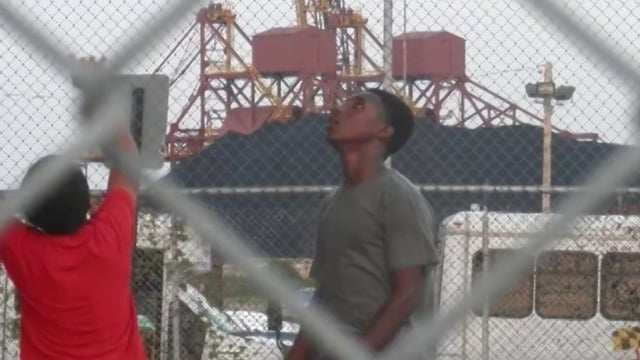
 In the Ambitious Bid to Reinvent South Baltimore, Justice Concerns Remain, insideclimatenews.org (Oct 02, 2023)
In the Ambitious Bid to Reinvent South Baltimore, Justice Concerns Remain, insideclimatenews.org (Oct 02, 2023)  Marvin Hayes Is Spreading ‘Compost Fever’ in Baltimore’s Neighborhoods. He Thinks it Might Save the City., insideclimatenews.org (Aug 20, 2023)
Marvin Hayes Is Spreading ‘Compost Fever’ in Baltimore’s Neighborhoods. He Thinks it Might Save the City., insideclimatenews.org (Aug 20, 2023)
Community energy[edit | edit source]
Solar power in Maryland is supported by the state's legislation regarding the Renewable Portfolio Standard and Solar Renewable Energy Credit (SREC) program. The target for renewable energy as of 2017 is 20% by 2020, including 2% from solar power.
According to the Maryland Energy Administration, Maryland is exposed to approximately 5.3kWh per square meter of solar energy on a daily basis, and as of 2016, the state had 508 MW installed which ranks Maryland 11th in the nation for installed solar capacity.
Climate action[edit | edit source]
Chesapeake Climate Action Network
In April 2007, Maryland joined the Regional Greenhouse Gas Initiative (RGGI) — a regional initiative, formed by all the Northeastern states, Washington, D.C., and three Canadian provinces, to reduce greenhouse gas emissions. W
Sustainable transport activism[edit | edit source]
Wikipedia: Hiking trails in Maryland (category)
Cycling activism[edit | edit source]
Wikipedia: Bike paths in Maryland (category)
Education for sustainability[edit | edit source]
Wikipedia: List of nature centers in Maryland
Environment quality[edit | edit source]
Maryland joined with neighboring states during the end of the 20th century to improve the health of the Chesapeake Bay. The bay's aquatic life and seafood industry have been threatened by development and by fertilizer and livestock waste entering the bay.
In 2007, Forbes.com rated Maryland as the fifth "Greenest" state in the country, behind three of the Pacific States and Vermont. Maryland ranks 40th in total energy consumption nationwide, and it managed less toxic waste per capita than all but six states in 2005.
In March 2017, Maryland became the first state with proven gas reserves to ban fracking by passing a law against it.
Food activism[edit | edit source]
- Filbert Street Community Garden, 501(c)3 non-profit organization, founded in 2010. Green space, education, Environmental Justice, Urban Wildlife and Combating the Food Desert project. added 10:45, 28 August 2023 (UTC)
Reduce, reuse, repair and recycle[edit | edit source]
- Baltimore Compost Collective, "youth-empowered collective, Black-owned business, building a diverse composting community in Baltimore", added 10:29, 28 August 2023 (UTC)
Resources[edit | edit source]
Apps for sustainability[edit | edit source]
Baltimore 311 enables real-time collaboration with citizens, "deputizing" mobile users to become the city's eyes and ears. Citizens report potholes, graffiti, and other issues from anywhere in the city using their mobile phone
Citizens data initiative[edit | edit source]
Energy Data & Statistics for Maryland - Maryland BayStat - Open Baltimore, City of Baltimore's open data catalogue
News and comment[edit | edit source]
2017
When Will Bikes Rule the City? May 19[1]
"Maryland passes ban on fracking" by @samanthadpage, Mar 28[2]
Upcycling Baltimore's vacant buildings tackles both empty houses and unemployment, by @eillieanzi, Feb 27[3]
2016
Maryland To Become First State In U.S. To Ban Bee-Killing Pesticides! July 17[4]
2015
8-Year Fracking Moratorium Bill Introduced in Maryland as Californians Demand Real Climate Action, Febraury 6[5]
Campaigns[edit | edit source]
We Demand Fair Development! Stop the Incinerator!
About Maryland[edit | edit source]
Maryland (US: MERR-il-ənd) is a state in the Mid-Atlantic region of the United States. It borders Virginia to its south, West Virginia to its west, Pennsylvania to its north, Delaware and the Atlantic Ocean to its east, and the national capital of Washington, D.C. to the southwest. With a total area of 12,407 square miles (32,130 km2), Maryland is the ninth-smallest state by land area, and its population of 6,177,224 ranks it the 19th-most populous state and the fifth-most densely populated. Maryland's capital is Annapolis, and the most populous city is Baltimore.
See also[edit | edit source]
References

